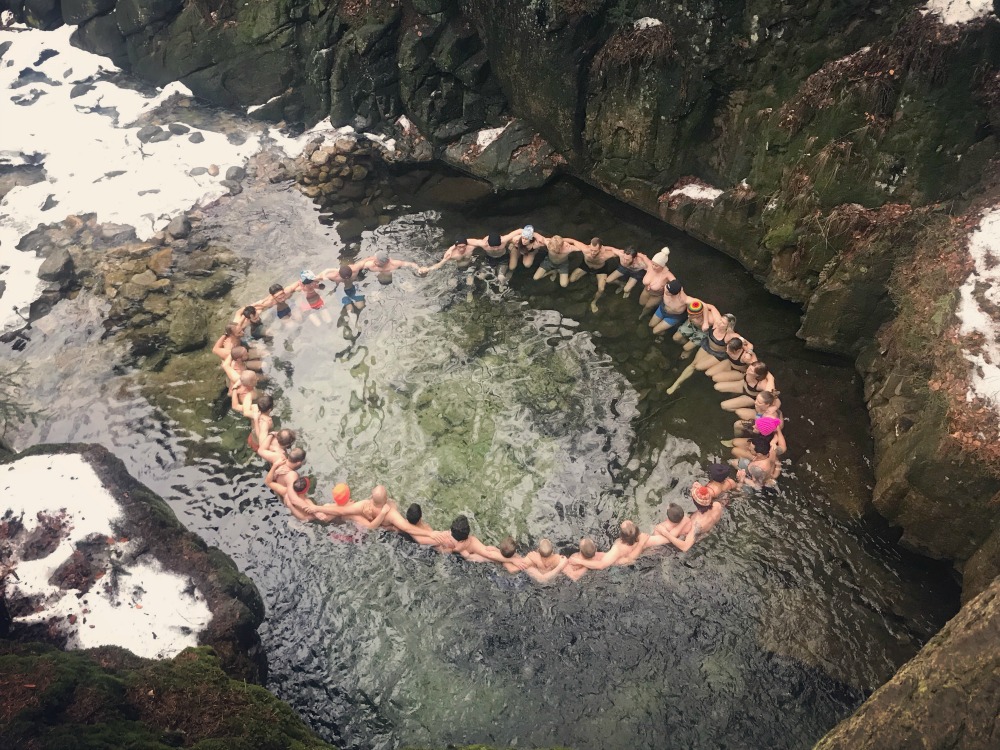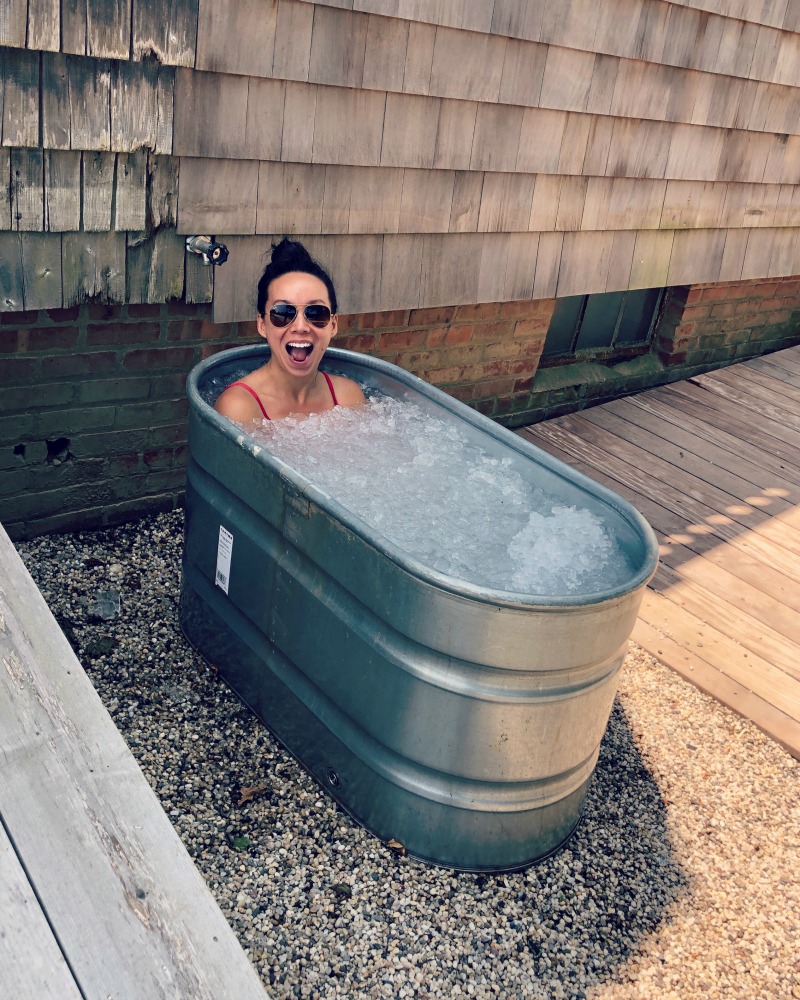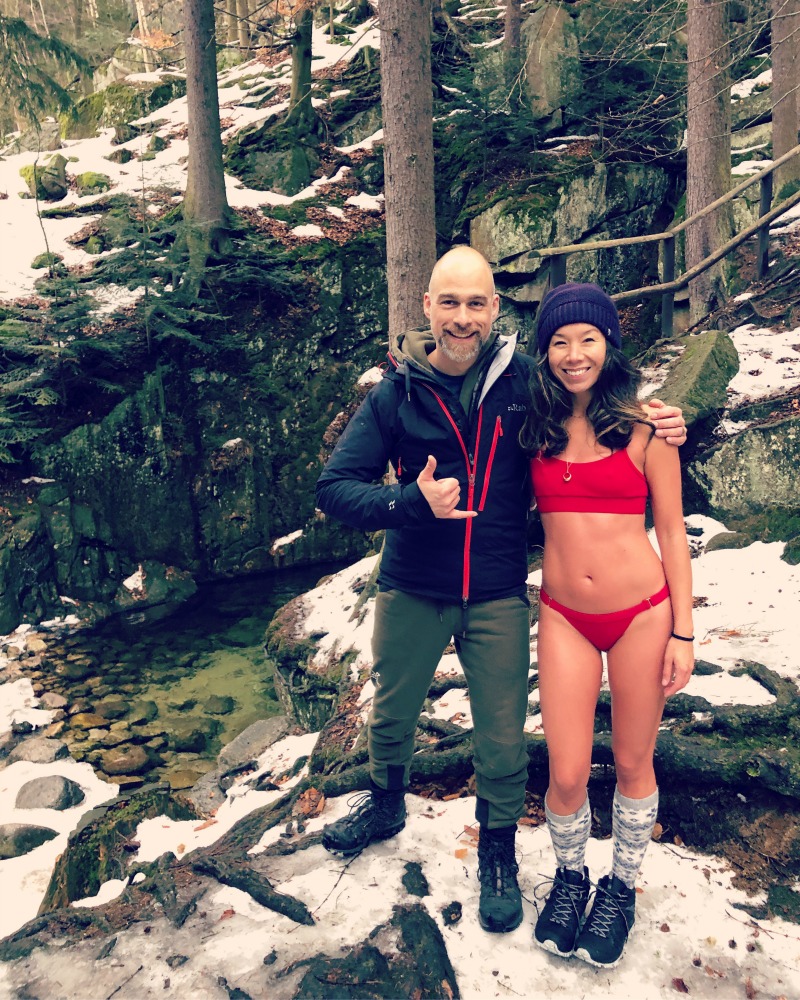How combining breathwork, yoga, meditation, and ice baths can transform the mind, body, and soul.
Sitting in a freezing cold river in Poland during a February cold snap, all I could think was, “If I lose a toe, I’m going to be really pissed.” Along with 40 other aspiring Wim Hof Method instructors on the first day of our training, I sat in that frozen river for five minutes. When I finally got out, blue–toed and numb, it took everything I had not to breakdown and cry. I was cold and tired and scared. Wondering what the hell I was doing here, training with a mad–cap, 59-year–old Dutch extreme athlete nicknamed “The Iceman.” Why did I feel the need to push myself to the point of extreme discomfort, risking frostbite and the loss of my small appendages? To calm down, I thought about my first ice bath just a year prior.
It was in Encinitas, a sunny little surf town 30 minutes north of San Diego, where I took that first icy dunk. I’d discovered the Wim Hof Method through friends who were posting photos of themselves taking ice baths and I was instantly intrigued. I’m not entirely sure why I was drawn to the ice, it just struck a chord somewhere inside me, and I really wanted to try it.
Developed by a Dutchman named Wim Hof, the Wim Hof Method is defined by three parts: Mindset, Breathwork, and Cold Exposure. In practice, we are instructed on basic techniques used to focus the mind, power breathing—usually five rounds of 30 deep and fast breaths with a period of retention after each round—and sitting in an ice bath for two to three minutes. This is all designed to promote robust and vibrant health in mind, body, and soul.
The breathwork felt like a revelation. I remember energy coursing through my body; my arms and hands became electric. Then there was this fleeting moment when it felt like I’d lifted up outside of my body. It was a wildly unexpected and unforgettable experience. Afterward, I felt cleaned out; I felt clear. Then we got into the ice. As soon I dropped in, I started hyperventilating. I couldn’t control my breathing, and I couldn’t slow it down. As someone who has been practicing yoga for 15 years with what I thought was a fairly comprehensive understanding of my body, I felt shocked and betrayed by my complete lack of control over it. After quietly panicking for about 30 seconds, I was slowly able to catch my breath and rein it back in. The next minute and a half went by quickly as the ice forced me to focus entirely on controlling my breath. After two minutes, I was very cold but also happy; invigorated and proud of myself for doing it. From the moment I stepped out of the ice bath and through the following week, I noticed a marked improvement in my energy and general attitude towards life. I couldn’t wait to get in the ice again.
The more I practiced with the Wim Hof Method, the better I felt. My health was steadily increasing—I wasn’t getting sick; I felt stronger both physically and emotionally, and I was happier and more engaged—it all felt decidedly good. So, I made the decision to learn as much as I could about the Wim Hof Method in the hopes that I could share it with other people, which is why I was sitting in that icy Polish river with a frozen smile on my face watching as my toes turned blue.
That week in Poland continued with more cold–training exercises: Walking outdoors barefoot on snow-covered ground in just our swimsuits for 20 minutes, jumping from a cliff into the freezing river, sitting in ice baths, and the final day culminated with a three–hour hike up a frozen mountain wearing nothing but a sports bra, shorts and hiking boots. By the end of that week though, having successfully completed challenge after challenge, I felt something let loose inside me. A deep and roiling strength emerged that I didn’t know I had. I even started laughing during that final hike, very aware of the cold but defiant and giddy from my own perseverance.
At its most basic level, the Wim Hof Method prescribes to the belief that what doesn’t kill us, makes us stronger. Wim Hof, with his 21 Guinness World Records (some have been successfully challenged and surpassed since he set them), has long been a source of amazement and curiosity. There are certainly skeptics about the good his method can do. At some point, scientists started asking how he could possibly manage to do things that seemed impossible—running a half marathon above the Arctic Circle wearing only shorts; swimming under ice for 66 meters; running a marathon in the Namibian desert without drinking any water.
Here are just a few ways Wim Hof and others believe that humans can benefit from cold–water immersion.
- It develops and strengthens the nervous system.Getting in the ice is a practice that helps you learn to regulate your body’s reaction to challenging stimuli and situations. It teaches us how to be comfortable in the uncomfortable.
- Exposure to the coldincreases cortisol, a stress hormone that decreases inflammation. Inflammation is how the immune system responds to foreign invaders like bacteria and viruses, and this response is crucial to our survival, but it can also be excessive. Flu symptoms like headache, fever, fatigue, and muscle pain are all symptoms of inflammation. So, limiting the body’s inflammation can vastly improve recovery from sickness or intense physical exertion. Professional coaches, trainers, and athletes have known about this particular benefit of cold–water immersion for a while. Getting in the ice has also shown positive results for people suffering from auto-immune diseases, which are the consequence of an overactive immune system triggering an inflammatory response, even when there are no foreign invaders present.
- It improves circulation and energy.You have 125,000 km of blood vessels in your body, enough to circle the globe three times, and that network supplies trillions of cells with oxygen and nutrition. When you get in the cold water, your blood vessels constrict and then when you get out, they dilate—applying pressure like this to close and open your blood vessels helps to strengthen your vasculature—just like any other muscle in your body. Strengthening your vasculature improves the circulation of your blood, which means your cells are getting more oxygen and nutrition, improving your energy level and with it, your mood.
While the physiological benefits are significant, the mental muscle it builds is the most compelling reason to start practicing breathwork and cold-water immersion. There’s a favorite quote of mine that comes from the philosopher and psychologist, William James, and I think it captures the essence of the Wim Hof Method: “Beyond the very extreme of fatigue and distress, we may find amounts of ease and power we never dreamed ourselves to own; sources of strength never taxed at all because we never push through the obstruction.”
By pushing ourselves through the breathwork and the ice, we are consciously pushing through our comfort zone and perceived limitations. We leave behind those self-imposed mental constructs that keep us thinking small, that keep telling us we can’t do it. Once we push through, we realize a strength that enables us to face life’s challenges with more ease and power.
Building the mental muscle and the mindset needed to carry ourselves calmly through stressful situations creates a foundation on which more personal happiness is possible. Change and stress are a constant in life, having the tools and training to strengthen your ability to meet those challenges successfully—without losing your peace, your perspective, or your sense of humor—is key to living a happier life.
In yoga, we move ourselves into these strange and uncomfortable shapes and learn to breathe through them—it requires complete attention to the mind and body, and the Wim Hof Method is the same. They are both meant to train the mind and body, to strengthen the vessel in which you are navigating human life. They provide opportunities for discovery—of your body’s innate intelligence, strength, and resilience. But ultimately, they are both practices designed to bring you back to the present moment—which is where you are the most awake, the most powerful, the most creative, and where you have the greatest potential for joy.
When I came back from Poland (with all my toes and fingers), I wanted to offer a class that included all the practices that had improved my physical, mental, and emotional health and changed my life: Yoga, breathwork, meditation, and cold exposure—and I wanted to package it in a way that felt accessible and fun. To me, the combination of all four of those practices creates a potent formula that I believe can truly lift up the mind, body, and soul. Philosophically, it also makes a lot of sense to me, as the practices of yoga and the Wim Hof Method run parallel to and complement each other. After jumping off a cliff into that river full of ice chunks, starting my own class and business suddenly seemed like another challenge I could rise to meet.
Curious?
Take the plunge! Sign up for a Wim Hof Method workshop near you. wimhofmethod.com







